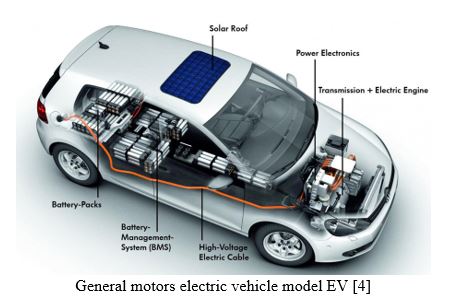Virtual Synchronous Converter Based Motor Drives for Future Electric Vehicles
by Md. Ruhul Amin - This article was updated on October 26, 2017
Greenhouse gases are not only responsible for the melting ice in polar regions on Earth but they are also causes of many incurable diseases. Presently, researchers concentrate on the minimization of greenhouse gases produced from petroleum based bulk-power plants, as well as, demotivate the civilians not to purchase petroleum driven vehicles rather than electric vehicles (EV). The Netherlands is planning on banning all non-electric cars by 2025 [1].
However, to run this EV, there are lots of motors and drivers that have already developed electric vehicles fleets. In general, smart EV takes power from the conventional electric grid in AC mode of power in either mode of transfer, for example, wired power-transfer or wireless power-transfer [2]. Moreover, the reintroduced Volkswagen Golf Electric Vehicle uses highly efficient roof top PV cells to harvest solar energy [3]. The AC is converted into DC power and stored in a highly efficient storage battery. In the case of proper combination of speed and torque, for a particular motor, the battery designs are varied for the purpose of applications of the vehicle. For example, General Motors uses an induction motor for their GM EVI model car [4]. In this vehicle, the stored DC power is to be converted again into AC having variable frequency for providing adequate and variable torque and speed in motor.
Now, the good quality of motor indicates the smooth and maximum bandwidth of controlling torques and corresponding motor speeds as well as angular wheel speed of EV. Ideally, traction motor gives nearly constant speed under small scale change in torque. Combustion engine based vehicles use multi-gear function in the transmission system to adjust the torque-speed variation of wheels. According to the principle of induction motor, when the supply voltage increases, the speed of the motor increases while torque decreases. On the other hand, when the current increases to motor, the torque increases while speed decreases and vice versa. In the other case, when the frequency increases, the motor provides low torque [4].
The output torque of the motor can be controlled by adjusting the field excitation. The high energy density is required to achieve the high torque in certain range of speed of the vehicle. In case of Permanent Magnet (PM), the size of PM increases whereas it allows less-control on magnetization [5]. However, induction motor possesses less copper losses in rotor winding and provides higher efficiency than the PM motor. The motor output torque can be adjusted by setting proper field current into the coil oriented induction motor. Another control technique is contactless control which uses two inverters simultaneously where each are half power rated and it can be extended to four times base speed at constant operating power otherwise that would be two times base speed. Therefore, it is clear that the torque of an induction motor can be released by Pulse Width Modulation (PWM) current control technique. Alternatively, excess torque can deteriorate the rotor speed, so it is also concerned to maintain the adequate level of voltage at motor winding. Hence, synchronous current control regulator can be used to retain the voltage and current.
The Virtual Synchronous Converter (VSCon) includes the mathematical model of a synchronous machine which behaves in the same way of synchronous machines [6]. Mathematically, as a Synchronous Generator (SG) provides a voltage supply and it has control principle consists of voltage and frequency regulation [7]. Since the output of SG depends on the angular speed of the rotor of SG as well as mechanical frequency, similarly, VSCon can control the inverter output voltage as well as current to be connected with vehicle motor by controlling the PWM in inverter. First of all, to accelerate the EV, initial torque is much higher than the torque at nominal speed of the vehicle. The control of acceleration can be selected by pedal in top-down methods producing numerical value to dynamic model of VSCon would produce appropriate frequency in application of variable frequency drive. In case of voltage control, similar methods can be applied where both cases would work on droop mechanism in VSCon. Then, the PWM signal controls the inverters. Finally, proper combination of voltage and current can be achieved in inverter to the motor to be driven in adjustable torque-speed.
Reference
[1]. Netherlands looks to ban all non-electric cars by 2025, By Story Hinckley, Staff APRIL 14, 2016, http://www.csmonitor.com/Environment/2016/0414/Netherlands-looks-to-ban-all-non-electric-cars-by-2025
[2]. Md. Ruhul Amin and Rajib Baran Roy, “Design and Simulation of Wireless Stationary Charging System for Hybrid Electric Vehicle using Inductive Power Pad in Parking Garage”, Proceedings of 8th International Conference on Software, Knowledge, Intelligent Management and Applications (SKIMA 2014), 18-20 December 2014, Dhaka, Bangladesh.
[3]. Alternative Energy, Alternative energy news and information about renewable energy technologies by Alex Ramon. http://www.alternative-energy-news.info/technology/transportation/electric-cars/
[3] Nanda, Gaurav, and Narayan C. Kar. "A survey and comparison of characteristics of motor drives used in electric vehicles." In Electrical and Computer Engineering, 2006. CCECE'06. Canadian Conference on, pp. 811-814. IEEE, 2006.
[4] Tiecheng, Wang, Zheng Ping, Zhang Qianfan, and Cheng Shukang. "Design characteristics of the induction motor used for hybrid electric vehicle." In Electromagnetic Launch Technology, 2004. 2004 12th Symposium on, pp. 523-527. IEEE, 2005.
[5] Ehsani, Mehrdad, Yimin Gao, and John M. Miller. "Hybrid electric vehicles: architecture and motor drives."Proceedings of the IEEE95, no. 4 (2007): 719-728.
[6] Zhong, QC and Weiss, G. Synchronverters: Inverters that mimic synchronous generators. IEEE Transactions on Industrial Electronics. 2011;58(4):1259–67.
[7] Amin MR, Zulkifli SA. Modelling of Virtual Synchronous Converter for Grid-Inverter Synchronization in Microgrids Applications. International Journal of Power Electronics and Drive Systems (IJPEDS). 2017, 7(4):1377-1385.
 |
Md. Ruhul Amin, was born in 1989 in Rajshahi, he is a member of IEEE including society of IEEE Power Electronics and IEEE Transpiration Electrification. He is working as a Lecturer in the Department of Electrical and Electronic Engineering at the University of Information Technology & Sciences (UITS), Dhaka, Bangladesh. Previously, he worked as a Graduate Research Assistant and Teaching Assistant, Faculty of Electrical and Electronic Engineering (FKEE), Universiti Tun Hussein Onn Malaysia (UTHM), Johor, Malaysia. He obtained his Master degree on Electrical Engineering from UTHM with research fellow. He served as an organizing committee members for several project competitions in UITS and IEEE in Bangladesh. He supervised a number of undergraduate student projects which have been indexed in the IEEE digital library. He was also connected with IT firm as a senior consultant and former system engineer at Master Mind Computer, Dhaka. He participated in numerous volunteer activities in Bangladesh and Malaysia. Recently, he also served as a Chairman of Postgraduate Students Society in FKEE, UTHM. He has a number of publications in renowned journals including international conference proceedings in his area of expertise. His research area addresses the issues related to Power Electronics Applications and Control; Distributed Generation and Control; Electric Vehicles. |
About the Newsletter
Editors-in-Chief

Jin-Woo Ahn
Co-Editor-in-Chief

Sheldon Williamson
Co-Editor-in-Chief
TEC Call for Articles 2023 - Advances in Charging Systems
The TEC eNewsletter is now being indexed by Google Scholar and peer-reviewed articles are being submitted to IEEE Xplore.
To submit an article click here.




